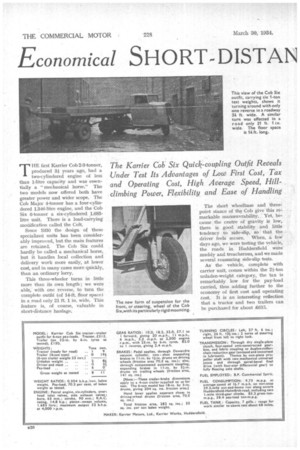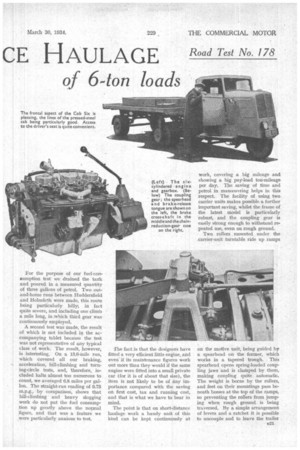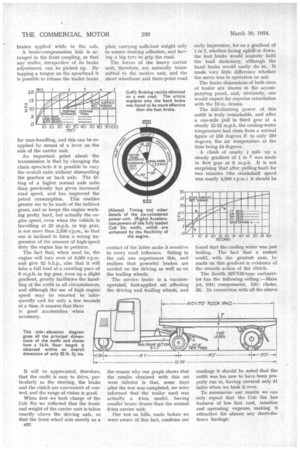Economical SHORT,DISTAN
Page 26

Page 27

Page 28

If you've noticed an error in this article please click here to report it so we can fix it.
CE HAULAGE
of 6-ton loads
Road Test No. 178
The Karrier Cob* Six Quick-coupling Outfit Reveals Under Test Its Advantages of Low First Cost, Tax and Operating Cost, High Average Speed, Hillclimbing Power, Flexibility and Ease of Handling
THE first Karrier Cob 2-3-tonner, produced 34 years ago, had a two-cylindered engine of less than 1-litre capacity and was essentially a "mechanical horse." The two models now offered both have greater power and wider scope. The Cob Major 4-tonner has a four-cylindered 1.346-litre engine, and the Cob Six 6-tonner a six-cylindered. 1.683litre unit. There is a load-carrying modification called the Colt.
Since 1930 the design of these specialized units has been considerably improved, but the main features are retained. The Cob Six could hardly be called a mechanical horse, but it handles local collection and delivery work more easily, at lower cost, and in many cases more quickly, than an ordinary lorry.
This three-wheeler turns in little more than its own length ; we were able, with one reverse, to turn the complete outfit (of 14-ft floor space) in a road only 21 ft. 1 in. wide. This feature is, of course, valuable in short-distance haulage.
The short wheelbase and threepoint stance of the Cob give this remarkable inanceuvrability. Yet, because the centre of gravity is low, there is good stability and little tendency to side-slip, so that the driver feels secure. When, a few days ago, we were testing the vehicle, the roads in Huddersfield were muddy and treacherous, and we made several reassuring side-slip tests.
As the vehicle, complete with carrier unit, comes within the 24-ton unladen-weight category, the tax is remarkably low for the pay-load carried, thus adding further to the economy of first cost and operating cost. It is an interesting reflection that a tractor and two trailers can be purchased for about £015. For the purpose of our fuel-consumption test' we drained the tank and poured in a measured quantity of three gallons of petrol. Two outand-home runs between Huddersfield and Holmfirth were made, this route being particularly hilly, in fact quite severe, and including one climb a mile long, in which third gear was continuously employed.
A. second test was made, the result of which is not included in the accompanying tablet because the test was not representative of any typical class of work. The result, however, is interesting. On a 13.6-inile run, which covered all our braking, acceleration, hill-climbing and turning-circle tests, and, therefore, included halts almost too numerous to count, we averaged 6.8 miles per gal lon. The ti.aight-run reading of 9.73 m.p.g., by comparison, shows that hill-climbing and heavy slogging work do not put the fuel consumption up greatly above the 'nopnaI figure, and that was a feature we were particularly anxious to test.
The fact is that the designers have fitted a very efficient little engine, and even if its maintenance figures work out more than they would if the same engine were fitted into a small private car (for it is of about that size), the item is not likely to be of any importance compared with the saving on first cost, tax and running cost, and that is what we have to bear in mind,
The point is that on short-distance haulage work a handy unit of this kind can be kept continuously at work, covering a big mileage and showing a big pay-load ton-mileage per day. The saving of time and petrol in manceuvring helps in this respect. The facility of using two carrier units makes possible a. further important saving, whilst the frame of the latest model is particularly robust, and the coupling gear is easily strong enough to withstand repeated use, even on rough ground.
Two rollers mounted under the carrier-unit turntable ride up ramps on the motive unit, being guided by a spearhead on the former, which works in a tapered trough. This spearhead opens spring-loaded coupling jaws and is clamped by them, making coupling quite automatic. The weight is borne by the rollers, and feet on their mountings pass beneath bosses at the top of the ramps, so preventing the rollers from jumping when rough ground is being traversed. By a simple arrangement of levers and a ratchet it is possible to uncouple and to leave the trailer brakes applied while in the cab.
A brake-compensation link is arranged in the front coupling, so that any trailer, irrespective of its brake adjustment, can be picked up. By tapping a tongue on the spearhead it is possible to release the trailer brake for man-handling, and this can be re applied by means of a lever on the side of the carrier unit.
An important point about the transmission is that by changing the chain sprockets it is possible to vary the overall ratio without dismantling the gearbox or back axle. The fitting of a higher normal axle ratio than previously has given increased road speed, and has improved the petrol consumption. This enables greater use to be made of the indirect gears, and so keeps the engine working pretty hard, but actually the engine speed, even when the vehicle is
travelling at 20 m.p.h. in top gear, is not more than 2,500 r.p.m., so that one is inclined to form a wrong impression of the amount of high-speed duty the engine has to perform.
The fact that, when need be, the engine will turn over at 4,000 r.p.m.
and give 52 b.h.p., also that it will take a full load at a crawling pace of 6 m.p.h. in top gear, even up a slight gradient, greatly facilitates the handling of the outfit in all circumstances, and although the use of high engine speed may be resorted to infrequently and for only a few seconds at a time, it ensures that there is good acceleration when necessary.
It will be appreciated, therefore, that the outfit is easy to drive, particularly as the steering, the brake and the clutch are convenient of control, and the range of vision is good.
When first we took charge of the Cob Six we reflected that the frontend weight of the carrier unit is taken exactly above the driving axle, so that the front wheel acts merely as a B22 pilot, carrying sufficient weight only to ensure steering adhesion, and having a big tyre to grip the road.
The forces of the heavy carrier unit, therefore, are naturally transmitted to the motive unit, and the short wheelbase and three-point road contact of the latter make it sensitive to every road influence. Sitting in the cab one experiences this, and realizes that powerful brakes are needed on the driving as well as on the trailing wheels.
The service brake is a vacuum operated, foot-applied set affecting the driving and trailing wheels, and the reason why our graph shows that the results obtained with this set were inferior is that, some days after the test was completed, we were informed that the trailer used was actually a 4-ton model, having smaller brake drums than the normal 6-ton carrier unit.
Our test on hills, made before we were aware of this fact, confirms Our early impression, for on a gradient of 1 in 7, whether facing uphill or down, ' the foot brake would scarcely hold the load stationary, although the hand brake would easily do so. It made very little difference whether the servo was in operation or not.
The brake dimensions of both sizes of trailer are shown in the accompanying panel, and, obviously, one would expect far superior retardation with the 18-in, drums.
The hill-climbing power of this outfit is truly remarkable, and after a one-mile pull in third gear at a steady 12-13 m.p.h. the cooling-water temperature had risen from a normal figure of 156 degrees F. to only 190 degrees, the air temperature at the time being 44 degrees.
A climb of nearly mile up a steady gradient of 1 in 7 was made in first gear at 6 m.p.h. It is not surprising that after pulling hard for two minutes (the crankshaft speed was nearly 4,300 r.p.m.) it should be found that the cooling water was just boiling. The fact that a restart could, with the greatest ease, be made on this gradient is evidence of the smooth action of the clutch.
The Zenith 33VEM-type carburetter has the following setting :—Main jet, 100; compensator, 120; choke, 26. In connection with all the above readings it should be noted that the outfit was too new to have been properly run in, having covered only 41 miles when we took it over.
To summarize our results we can only repeat that the Cob Six has features of low first cost, taxation and operating expense, making it attractive for almost any short-distance haulage.












































































